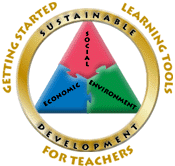|
|
| |
Hello and welcome to the Learning Modules. To help you navigate through this portion of the web site, we recommend reading the following brief notes before proceeding.
 Clicking on the circle will take you to the Sustainable
Development page, which gives an introduction to some commonly held views on what
sustainable development is. Clicking on the words surrounding the circle will take you to
the features that support the learning modules, including the learning tools matrix, the
teachers' area, and this getting started area.
Clicking on the circle will take you to the Sustainable
Development page, which gives an introduction to some commonly held views on what
sustainable development is. Clicking on the words surrounding the circle will take you to
the features that support the learning modules, including the learning tools matrix, the
teachers' area, and this getting started area.
And, of course, there are the specific Learning Modules themselves, which can be accessed through clicking on the module titles listed to the right of the icon.
To allow for the greatest flexibility, each page within the individual modules is introduced by a heading and button bar that acts as both an outline of the module and a navigation tool. A sample is shown here, followed by explanations of each feature.

1. Learning Modules Icon |
 |
Throughout the site, this icon appears in the upper left hand corner to let you know where you are. When it reads "Learning Modules," you can click on the icon to return the learning modules index page, thus giving you access to all of the features described above.
Learning Modules are divided into three sectors -- social, economic and environmental. Each sector contains modules that explore
different issues of sustainable development through a specific indicator. Currently, these include population growth rate, gross national
product (GNP) per capita , and access to safe water.
Over time, we will add more sectors and learning modules, as well as improve and build
upon the existing ones, incorporating new data and feedback and suggestions from users
like you.
2. Getting Started |
The Getting Started button will bring you to this page.
3. For Teachers |
For Teachers is an area intended for classroom teachers. It contains linear versions of all module activities (with and without answers) that may be printed out for off-line classroom use. This file also contains an introductory section that addresses issues of particular concern to teachers, such as the goals and objectives of the learning modules and the point of view of the materials. We also invite teachers to visit our For Teachers Guestbook to give feedback and share ideas on how to best teach about sustainable development. We look forward to expanding the For Teachers area as we receive feedback and as the website matures.
4. Learning Tools |
The Learning Tools button will take you to the Matrix of Learning Tools, a site map of all the activities in the Learning Modules area.
Each module contains several tools which describe the indicator. These include:
a) text, b) a world map c) charts and graphs, d) a data table with specific statistical information for individual countries over time, e) photos, f) case studies based on real situations that illustrate some of the concepts introduced throughout the modules, and g) research and explore activities to examine the issues surrounding the indicators in more depth and in your communities.
Before attempting the research and explore activities, you should be familiar with the rest of the module and the general concepts and issues involved.
Each module has activities associated with the specific learning tools. At the bottom of each learning tool screen, you will see a link that invites you to "explore," for example, Explore the Text. Once you have completed the activities, you can call up the answers and check your work.
The Test Yourself text link allows you to answer questions on-line and to compare your answer with the suggested answer. This area of the website can only be accessed by users with browsers which enable JavaScript.
We recommend that you approach the individual modules in a linear fashion: 1) select a sector to explore (social, economic, or environmental), and read the introduction; 2) choose an indicator within this sector (e.g., GNP per Capita); and, 3) work through the module in order of the tools on the lower row of buttons: text, map, charts, data table, photos, case studies, and research and explore.
e.g., 1) Economic (sector), 2) GNP per Capita, 3)![]() 4)
4)![]() 5)
5)![]() 6)
6)![]() 7)
7)![]() 8)
8)![]()
As you go along, you will find hyperlinked terms throughout the text and activities.
These terms are defined in the Glossary, which can also be accessed by the ![]() button.
button.
Unless otherwise noted each page has been designed to be printed out in a black-and-white format. The only exception to this are the maps, several of which have been specially customized for printing and are located in the Map Print Folder. Note: Because these print map files contain a lot of information, they are rather large. (e.g., 100K).
Several of the learning tool activities involve using a blank comparative data table. Feel free to use ours or create your own.
-----------------------------------------------------------------------------------------------------
Because this is a new site, we'd greatly appreciate your thoughts and comments on it. If you haven't done so already, please take a few minutes to sign our guestbook.
[ Getting Started ] | [ Learning Tools ] | [ For Teachers ]
[ Social ] | [ Economic ] | [ Environmental ]
[ PopulationGrowth Rate ] | [ GNP Per Capita ] | [ Access to Safe Water ]
Home
| Site Guide | Modules | What's SD? | SD Post | Resources | About DEP | Feedback| Copyright � 1998
IBRD/The World Bank |
[email protected] |